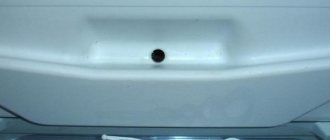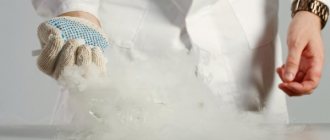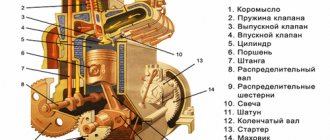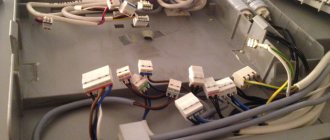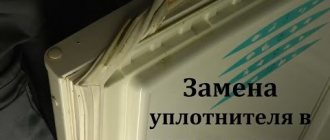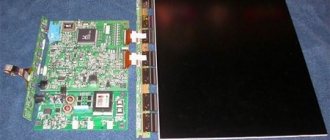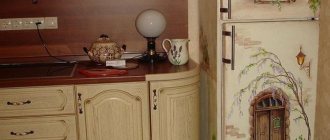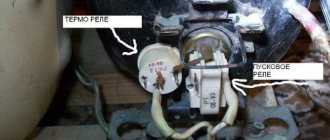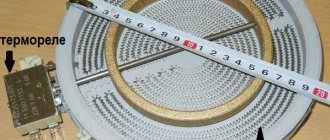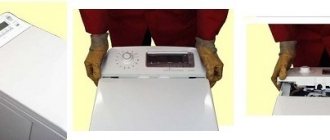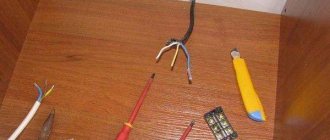Features of operation and main parts of the refrigerator
The side walls of the refrigerator and the body (back panel) are made of metal, and the internal surfaces are made of durable polystyrene; the gap between them is filled with insulating material. The trouble-free operation of the refrigerator is ensured by the absolute sealing of the refrigerator wall and internal compartments.
Due to incorrect operation, the rear wall of the refrigerator is exposed to water and ice, resulting in the formation of condensation. This leads to malfunctions. Destruction of the metal case and parts installed on the back wall of the refrigerator.
The warranty on the refrigerator body is 5 years, subject to proper use. Typically, users provide complaints that the back wall of the refrigerator inside the chamber quickly becomes covered with ice. The reason for this phenomenon is a violation of the defrosting technology and use.
Failure to comply with the requirements for use leads to various damage to the rear wall of the refrigerator.
Refrigerator malfunctions and repairs
Freezing of the cabinet causes ice to accumulate on the back wall of the refrigerator compartment. Freezing in refrigerators is observed in several places, this is the so-called freezing of the rear wall along the evaporator tube, freezing of the “neck” , freezing of the “roof” .
…
To work with the back wall, the following tools and devices are required: Knife; Sanding paper; Adhesive tape; Protective gloves; Respirator; Roulette, long ruler; A two-component mixture for foaming the cut out part of the insulation; you can use mounting foam; Wooden spatula; Polyethylene film 30x1000mm; 2-3 flat weights weighing 5-8 kg;
First, you need to clarify the freezing zone. We already know approximately, because... saw ice inside the refrigerator. We seal the refrigerator doors with tape to prevent them from opening. Then we place the product on the stands with its back facing up. Having unscrewed the 4 screws securing the condenser, we move it to the side, approximately so that the side of the condenser lies diagonally to the body of the refrigerator, and fix it with 1 screw in this position. This provides access to the “operated” part of the refrigerator. If you press your finger on the insulation in the freezing zone, a hole remains and moisture is released. Next, we proceed to cutting out the insulation of the refrigerator cabinet in the freezing zone. An approximate area is shown in the figure:
We carry out the work carefully so as not to damage the inner cabinet and the tube running in the center of the cutting area. The insulation is removed all the way to the inner cabinet; we use a wooden spatula to remove it! If there is a “felt boot” on the back wall of the refrigerator, that is, an oval bulge, at this stage . So, if we have a “felt boot”, with a sharp knife we cut out a convex area with a length equal to the size in the figure, and a width approximately 5-10 mm less than the width of the felt boot. If after removing the insulation there are still wet places on the sides, trim them or dry them with a hairdryer. There are several spacer rings installed on the tube; remove and clean. At the top, the place where the evaporator tube enters the cabinet is hermetically sealed either with a plug or a rubber bushing. In this place, when cleaning from foam, we work especially carefully! The lower part of the cut out area may reach the drain tray, the need to clean the foam is determined by the state of the foam in that place - wet means we cut further. There may be water at the bottom of the cut channel, naturally we remove it. A little lower than the tube entry into the cabinet there is another plug; we also clean it very carefully. At this point, the preparatory work can be considered completed. Now the reverse process of working to eliminate freezing begins. Next, we install the spacer rings in place, seal the tube insertion and the plug around the perimeter with paste or silicone. We wait for the sealant to harden. Next, if the refrigerator has a felt boot, you need to make a device in the shape of the convexity that was just cut out. It can be bent from tin, it is necessary in order to reproduce the carved “felt boot” as accurately as possible. If the back wall of the refrigerator is flat, prepare cardboard for the entire length of the channel. Prepare a two-component mixture. The consumption rate for 1 cabinet is 120g. (A-50g. B-70g.) Mix the components until a homogeneous mass is formed (it is better to use an electric drill), the mixing process should not take more than 20 seconds! We pour the mixture into the channel evenly and quickly, cover it with film, then with cardboard or a mold, put weights on top, and leave a small “casting” at the bottom. If we use polyurethane foam, then the steps are exactly the same. After about 20-25 minutes, you can remove the “fortifications” and marvel at what happened. We check for deep pores or unfoamed areas. If everything is fine, cut off the excess foam with a knife and clean the protrusions with sandpaper. Next, carefully seal the foaming area with adhesive tape and return the capacitor to its place. And here are described methods for eliminating defects : freezing of the “neck” and “roof”
Did you do a good job? For a pleasant rest and sleep, use cotton - practical and comfortable underwear in the Cotton Paradise store.
When is a master needed?
If you notice in the refrigerator:
- Ice freezing inside the back wall of the refrigerator;
- swelling of the outer surface of the body;
- you have to defrost the refrigerator too often;
- if, when removing accumulated ice, the evaporator housing was damaged;
- insufficient cooling of products.
Then the rear wall of the refrigerator needs to be repaired. Restoring the back wall of a refrigerator is one of the inexpensive types of repair, but in most cases it requires delivery of the equipment to a workshop.
Refrigerator repair service center
Conventionally, refrigerator breakdowns can be divided into several groups:
- The device does not turn on . There is likely a problem with the motor, it is quite possible that it has burned out, and it is the motor that ensures the functionality of all other elements. Sometimes the power cord is damaged;
- The refrigerator does not generate enough cold . In such situations, we can talk about a whole range of possible damages. In the simplest case, the cold is simply not retained inside, since the seal located around the perimeter of the door has dried out, cracked, and lost its tightness. Replacing it is a matter of a couple of tens of minutes, the cost of repairs is minimal. In more complex cases, the matter may concern compressor failure, breakdowns of the electronic control unit (most relevant for modern devices), and loss of radiator efficiency. The exact cause is determined during diagnosis;
- The refrigerator does not respond to changing settings . There may be a loss of communication between the controls and the motor. The case may concern physical wire breaks and electronic problems;
- The refrigerator often turns off . As a rule, this is due to overheating of the compressor or radiator. Freon leakage, contamination, depletion of service life - there are many reasons.
If we talk about what kind of guarantees there are for refrigerator repairs, then, regardless of the work performed, the master vouches for its quality, providing a long warranty period (for original spare parts it is 3 years), during which all defects are eliminated free of charge in a minimum time.
Why does the back wall of the refrigerator freeze?
The main reason is the destruction of the thermal insulation material of the inner wall of the refrigerator. Ice begins to freeze around the defect, destroying the insulation even further, reaching the side walls of the refrigerator.
Over time, moisture gets inside the material, which leads to the destruction of its insulating properties. Because of this, the back wall of the refrigerator requires immediate repair.
The formation of ice deposits on the rear wall can be affected by the loss of freon, and as a result, the appearance of frost on the side walls and tubes where it should not be.
Violation of the temperature regime leads to a layer of snow falling on the back wall. Quite often, the cause of ice deposits is abrasion of the rubber door seals. The appearance of snow on the back wall and in the freezer occurs non-stop.
Cost of repairing a refrigerator at home
| Name of works | Price |
| A technician will visit your home in the city | from 0 rub |
| Diagnosis of faults during subsequent repairs | from 0 rub |
| Doesn’t freeze, doesn’t cool, doesn’t turn on, doesn’t turn off, gives an error, beeps | |
| Refrigerant leak, microcracks in the gas system | from 630 RUR |
| Failure of the motor-compressor | from 1450 rub. |
| Gas system capillary tube clogged | from 850 rub. |
| Gas system dryer filter clogged | from 350 rub. |
| Solenoid valve failure | from 730 RUR |
| Damage to the thermostat or temperature sensor | from 830 RUR |
| Breakdown of the start-protection relay | from 370 rub. |
| No Frost system malfunction | from 530 rub. |
| Control module is faulty | from 950 rub. |
| Very cold, freezing | |
| Failure of the motor-compressor | from 1450 rub. |
| Solenoid valve failure | from 730 RUR |
| Damage to the thermostat or temperature sensor | from 830 RUR |
| No Frost system malfunction | from 530 rub. |
| Control module is faulty | from 950 rub. |
| Ice or snow coat inside | |
| Refrigerant leak, microcracks in the system | from 630 RUR |
| Failure of the motor-compressor | from 1450 rub. |
| Gas system capillary tube clogged | from 850 rub. |
| Gas system dryer filter clogged | from 350 rub. |
| Solenoid valve failure | from 730 RUR |
| Damage to the thermostat or temperature sensor | from 830 RUR |
| Increased noise, rattles, buzzes | |
| Damage or failure of the fan | from 450 rub |
| Failure of the motor-compressor | from 1450 rub. |
| No Frost system malfunction | from 530 rub. |
| Water inside or outside | |
| Possible overflow of the tray, its damage | from 250 rub. |
| Drainage system for draining melt water | from 350 rub. |
| No Frost system malfunction | from 530 rub. |
| Possible breakdowns in the gas system | from 450 rub |
| Additional services | |
| Repairing or replacing the hinge of a built-in refrigerator | from 630 RUR |
| Refrigerator prevention | from 370 rub. |
| Overhaul of the refrigerator gas system | from RUB 2,630 |
| Overhaul - restoration repair of the electrical or electronic system of the refrigerator | from 1,980 rub. |
| Replacing the combined gas system with a copper one. Warranty of 10 (ten) years! | RUB 14,999 |
Prices are indicated only for work; the cost of the replacement part will be announced by the technician after diagnosis, specifying the exact price of the original spare part immediately over the phone. The price of the work may vary depending on the complexity of the installation and the model of your washing machine. After agreeing on the price, the master begins the repair. Upon completion of the repair, the master leaves a guarantee on his work. If you refuse repairs, you only pay 500 rubles for diagnostics.
Inexpensive refrigerator repairs in Moscow
Contacting our refrigerator repair service center is beneficial for a number of reasons:
- Low prices . Market analysis clearly demonstrates that our proposals in terms of cost are much lower than those of competitors;
- Solving any problems . We work with refrigerators regardless of their brand, year of manufacture, or type. Both old mechanical models and new electronic devices with No Frost systems and touch controls are successfully repaired;
- Free departure . There is no need to take the device for service; the arrival of a technician does not increase the cost of the work.
Contact our best refrigerator repair in Moscow, our professionalism and attitude to work will please even the most demanding clients!
Refrigerator repair experts today on orders in Moscow
| Free home appliance repair technicians. We are ready to go for repairs in the service area or nearby areas within an hour. |
| Masters who repair household appliances in Moscow. We are ready to come to your home within 2-3 hours or at a time agreed upon with you. |
